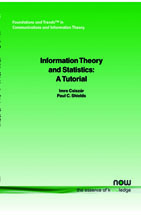Information Theory and Statistics: A Tutorial
By I. Csiszár, Rényi Institute of Mathematics, Hungarian Academy of Sciences, Hungary, csiszar@renyi.hu | P.C. Shields, University of Toledo, USA, paul.shields@utoledo.edu
Abstract
This tutorial is concerned with applications of information theory concepts in statistics, in the finite alphabet setting. The information measure known as information divergence or Kullback-Leibler distance or relative entropy plays a key role, often with a geometric flavor as an analogue of squared Euclidean distance, as in the concepts of I-projection, I-radius and I-centroid. The topics covered include large deviations, hypothesis testing, maximum likelihood estimation in exponential families, analysis of contingency tables, and iterative algorithms with an "information geometry" background. Also, an introduction is provided to the theory of universal coding, and to statistical inference via the minimum description length principle motivated by that theory.
Information Theory and Statistics
Information Theory and Statistics: A Tutorial is concerned with applications of information theory concepts in statistics, in the finite alphabet setting. The topics covered include large deviations, hypothesis testing, maximum likelihood estimation in exponential families, analysis of contingency tables, and iterative algorithms with an "information geometry" background. Also, an introduction is provided to the theory of universal coding, and to statistical inference via the minimum description length principle motivated by that theory.
The tutorial does not assume the reader has an in-depth knowledge of Information Theory or statistics. As such, Information Theory and Statistics: A Tutorial is an excellent introductory text to this highly-important topic in mathematics, computer science and electrical engineering. It provides both students and researchers with an invaluable resource to quickly get up to speed in the field.
